An employment contract is a document that you would sign after joining a firm. It is both a legal and a formal procedure to ensure the smooth functioning of the firm.
Recently, the New York government has proposed employment contract reforms to make workforce management more transparent and employee-friendly. Similarly, other US states and economically established countries are considering such moves to stabilize their corporate sector. This makes it essential for employers as well as employees to learn its nitty-gritty well.
Therefore, we have provided a detailed explanation of its facets that will help you in learning all its domains and dimensions holistically.
What is an Employment Contract?
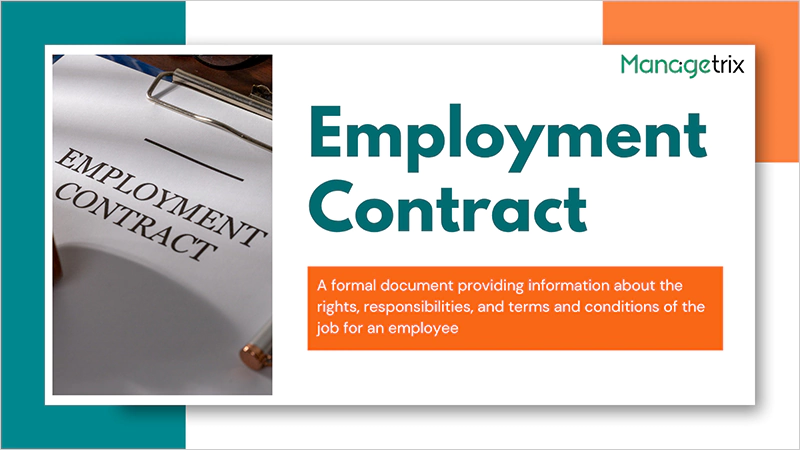
An employment contract is a formal document providing information about the rights, responsibilities, and terms and conditions of the job for an employee. It is signed by these two parties when the employee joins a designation at the firm.
Apart from the basic personal and tenure-related information, it also contains details of the pay and perks, compensation, terms of confidentiality, and termination.
It is considered the most crucial employment document, after an appointment letter, which specifies the terms, conditions, roles, and responsibilities of an employee to keep up to the expectations of the employer.
This document is classified into certain types that you must know to understand it better.
Suggested Read: Best Skills to Put on a Resume to Get Shortlisted in 2025
Types of Employment Contract
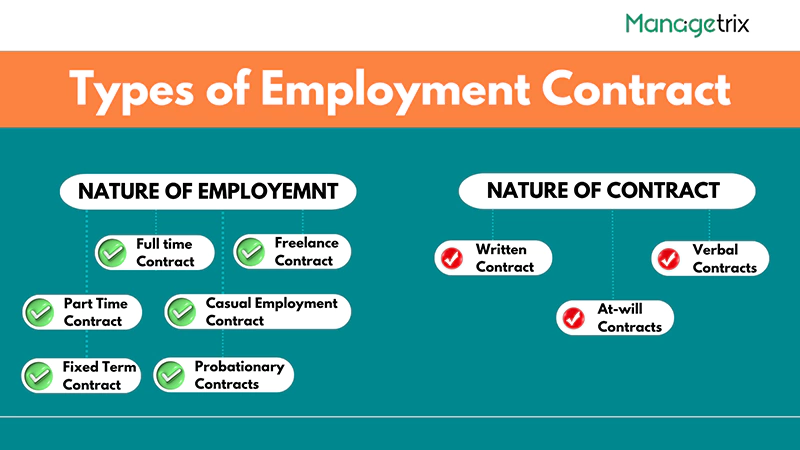
The contract of employment is categorized based on the nature of the contract and the nature of the employment. This classification helps in maintaining the segregation of employees and complying with the local regulations effectively.
Here are the major types of employment contracts that you must know.
Based on the Nature of the Contract
- Written Employment Contracts: They clearly specify the provisions and conditions in the agreements. As they are precise and easier to enforce and claim, they are preferred over other contract types.
- At-will Employment Contracts: These agreements provide the flexibility for both parties to opt out of the agreement anytime. The employee can be terminated by the employer or can resign at their will.
- Verbal Employment Contracts: These contracts of employment are either based on specific employment terms or can be at-will contracts. Generally, they are legally binding in nature. Such agreements are enforced based on the available evidence, such as emails.
Based on the Nature of Employment
- Full-time: This contract is signed to specify the employment conditions of a full-time employee working permanently for the firm. The agreement must clearly mention the mode of work of the employee, i.e., on-site, hybrid, or work from home.
- Part-time: Such contracts are signed by the part-time employees who are hired for a specific short time or to complete a specific task within a provided time.
- Fixed Term: These contracts mention the start and end dates of the contract and have less flexibility in their terms and conditions.
- Casual Employment Contract: For employees who are not under the obligation of working for specific hours, are brought under the agreement of such contracts.
- Freelance Contract: The freelancer and independent professionals of the firm are covered under this contract, who are employed on a work-target basis and not on a fixed-hour basis.
- Probationary Contracts: This contract enables the company to hire probationers for a specific duration.
Fact: A Zero-Hour Contract is a type of employment contract in the United Kingdom in which the employer is not bound to provide a minimum number of working hours to the employee.
Major Elements of the Employment Contract
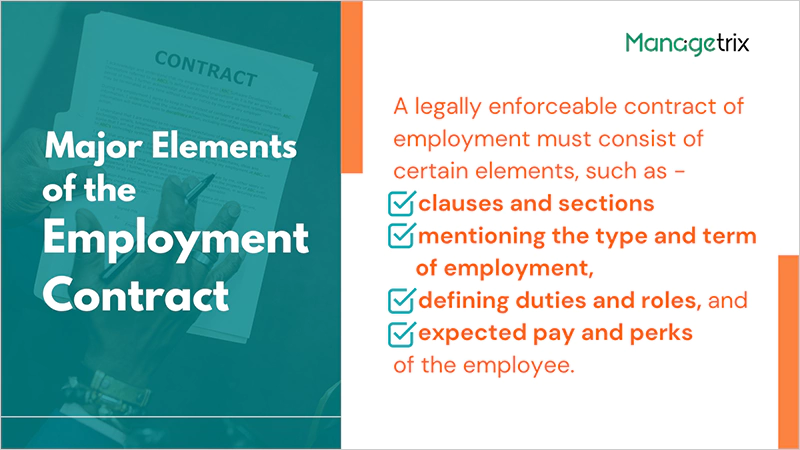
A legally enforceable contract of employment must consist of certain elements, such as clauses and sections mentioning the type and term of employment, defining duties and roles, and expected pay and perks of the employee. These components are essential in defining the details and obtaining the consent of both parties involved.
Here are the mandatory elements that you must check in a formal and legal employment contract.
- Employment Type: It must specify the type of employment of the employee, i.e., full-time, part-time, contractual, or temporary, etc. This helps in defining the nature of the work relationship between the employer and employee.
- Terms of Employment: The terms cover the working hours and general conditions of employment, which establish expectations for both parties to ensure clarity and fairness in the contract.
- Duties and Responsibilities: This section specifies the job role, tasks, and performance expectations of the employee by the employer. It helps the employee understand their key functions and obligations.
- Compensation and Benefits Offered: The contract should mention the salary, incentives, bonuses, and allowances. It can also include additional perks like health insurance, leaves, retirement benefits, or provisions related to imputed income.
- Expense Reimbursement Terms: These clauses mention the procedures to incur the work-related expenses of the employee. This ensures employees are fairly compensated for any business-related costs.
- Provisions of Confidentiality and Non-disclosure: The employment contract must have provisions and clauses for confidentiality and nondisclosure to ensure that employees maintain secrecy of the crucial business data even after the end of the contract.
- Job Tenure and Leave Policies: Such clauses are mentioned in the employment agreement to cover the duration of the contract for the employees and segregate them into fixed, permanent, or part-time employment types. It also contains the provisions and policy for different types of days off, such as bereavement leave, for which the particular employee is eligible.
- Conditions for Termination: This section in the employment contract includes the grounds on which the employment can be ended by any of the parties involved.
- Resignation: The contract of employment should include procedures the employee must follow while resigning from the post. It typically covers notice period length and instructions about handing over responsibilities.
- Dispute Resolution: The agreement should include the provisions related to the settlement of any prospective dispute. It can contain the clause related to arbitration, litigation, and mediation.
- Health and safety provisions: Employers should be committed to providing a safe working environment and medical support. It ensures employee well-being during casual and workplace emergencies, particularly in high-risk jobs.
- Modification and Amendments: The agreement should also specify how and when changes can be made. This ensures that modifications are valid only through mutual consent and documentation through the procedural provision.
Some established and renowned firms have made signing such agreements mandatory for the entire workforce, while others use this facility for certain types of employees, which are discussed next in the sequence.
Employment Contract Template
The contract of employment varies depending on the country where the business is established. However, we are providing you with a comprehensive employment contract template that you can consider for your new recruitments.
Here is a finely structured contract template for employment that you can amend and use as per your requirements:
We have left blank spaces for the required information that must be filled out officially. As the local laws vary from state to state, make sure our template adheres to the prevailing labor and corporate laws.
Who Needs an Employment Contract?
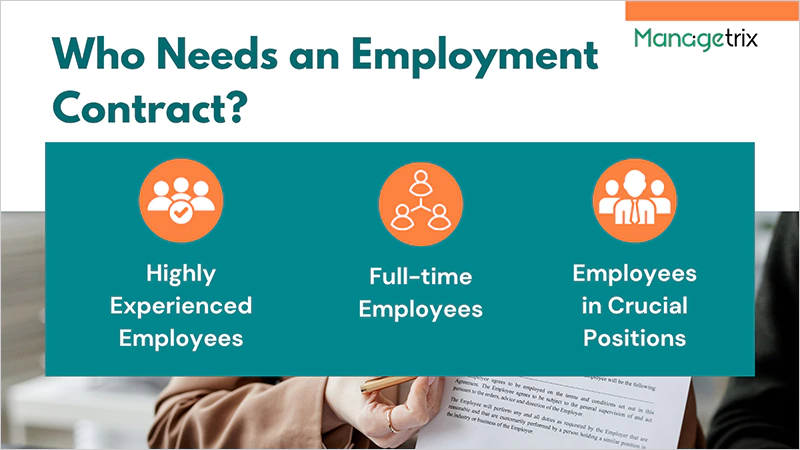
Firms like Google and Microsoft have made it mandatory for all their employees to sign a formal employment agreement. However, other medium and small-sized firms have made it optional for the workforce, but made it compulsory for certain groups of employees who are important for the growth of the firm. These groups include:
- Highly Experienced Employees: A contract safeguards the interests of adept employees and the employer’s investment in them. Senior employees expect transparent conditions and job security, making formal agreements essential for mutual trust.
- Employees in Crucial Positions: Professionals holding key roles influence core business outcomes. So, written contracts help define their significant roles and responsibilities. Having their terms in writing ensures business continuity and prevents complications over duties or benefits.
- Full-time Employees: Permanent staff contribute consistently to the growth of the firm, making a job contract essential to formalize work conditions for employee retention and security. Legal agreements help outline leave policies, salary, and benefits, supporting a productive work relationship.
Irrespective of the type of employee or contract, this agreement is highly valuable because of its notable benefits, which are next to be discussed next in the topic.
Also Read: What Is a Joining Letter? The Professional Template You Need to Make First Impression Count
Benefits of an Employment Contract
An employment contract is beneficial for the employer to retain a good quality workforce and helps the employee to get a formal confirmation of their roles, responsibilities, net pay, and perks. As it is a legal document, both parties involved get a definite and legitimate validation of the terms of employment.
In this perspective, here are the notable benefits that employers and employees will enjoy by signing an employment agreement.
- Outlines the Terms: A contract of employment defines clear working guidelines for both parties. Employees know exactly about their role, pay, and benefits through the agreement.
- Enhances Job Security: A written agreement protects workers from uncertain dismissal, which provides them with stability in their jobs. By explaining the expectations, it offers job security and peace of mind to the workers for long-term growth in a role.
- Protect the Firm’s Information: Confidentiality clauses secure the company’s sensitive data, making it difficult to leak details or be shared with other firms, especially competitors. The confidentiality and non-disclosure provisions restrict employees from revealing trade secrets, ensuring intellectual property remains protected.
- Checks disputes: Such agreements nullify confusion and misunderstandings regarding the terms and conditions of an employee’s role. If a disagreement arises, the contract acts as a reliable reference to resolve it quickly and fairly.
How to Structure an Employment Contract Judiciously?
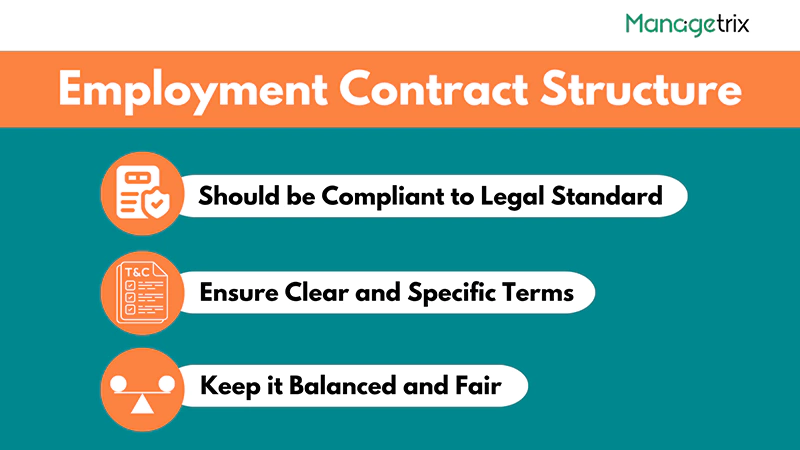
For employers, it is necessary to format an employment contract correctly to ensure it serves its core purpose. However, keeping certain fundamental points in mind will help in making a structurally fit and decently purposeful agreement. These points are:
- Ensure Clear and Specific Terms: Every part of the agreement should specify responsibilities and expectations with no ambiguity, which helps employers and employees to perform their duties effectively. Precise definitions reduce misunderstandings, making the contract a reliable guide for making decisions.
- Keep it Balanced and Fair: A thoughtfully drafted contract gives equal weightage to employee welfare and business needs, which builds trust. For lasting engagement, terms must be transparent and considerate of both sides. A balanced agreement also checks future disputes and builds a collaborative work environment for the staff.
- Should be Compliant to Legal Standard: Contract of employment should always reflect regulations prevalent in the industry and region. Staying updated with legal requirements helps the company stay compliant and protects the rights of both parties.
Conclusion
The above discussion self-evidently explains that an employment contract is an essential formal document that clarifies roles, rights, responsibilities, and benefits for both the employer and employee. Defining clear terms and protecting sensitive information reduces conflicts and promotes trust among the parties involved. As laws evolve, especially with recent reforms like those in New York, updating contracts to comply with legal standards is necessary for a fair and secure workplace.
Next Read: How Many Pay Periods in a Year? 2025 Employee’s Guide
FAQ
1. What is a contract of employment?
Ans: A contract of employment is a formal document used as part of employment formality that specifies the roles, responsibilities, privileges, and compensation of the employee.
2. What is the most common type of employment contract?
Ans: The most common type of employment contract is the written employment contract.
3. What are the 3 types of employment contracts?
Ans: The three types of employment contracts are at-will contracts, written contracts, and verbal contracts.
4. Do contract employees get benefits?
Ans: The contract employees get benefits as mentioned in the agreement. However, they get better job security than the non-contacted workforce.